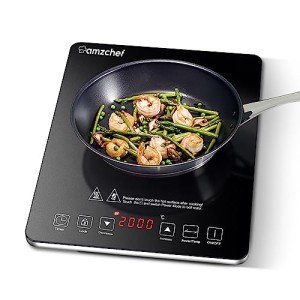Energy-Efficient Induction Hobs: A Comprehensive Guide
Induction hobs have emerged as a popular cooking solution among modern families, applauded for their speed, performance, and safety. As the world ends up being more conscious of energy intake and ecological sustainability, energy-efficient induction hobs are paving the way for cleaner and more effective cooking approaches. This short article explores the operations, benefits, and considerations of induction hobs, supplying an informative guide for those looking for to make the switch.
What is an Induction Hob?
Induction hobs work on the principle of electro-magnetic induction. Unlike conventional gas or electrical hobs, which warm up the cooktop surface area, induction hobs create heat directly in the pots and pans. This is achieved through magnetic fields that are produced when an induction coil is energized. The benefits of this technique extend beyond performance, as it also boosts safety and cooking performance.
Key Features of Induction Hobs
- Fast Cooking: Induction hobs substantially minimize cooking time compared to conventional techniques. They can boil water nearly two times as quick as electrical hobs.
- Energy Efficiency: Approximately 90% of the heat produced is moved straight to the cookware, minimizing energy waste.
- Exact Temperature Control: Users can control heat levels with remarkable precision, which is particularly beneficial for fragile jobs like simmering and melting.
- Cool Cooktop Surface: The cooktop remains fairly cool, decreasing the danger of burns and making cleansing much easier.
- Security Features: Many induction hobs come equipped with automated shut-off functions, recurring heat signs, and child lock features.
Benefits of Energy-Efficient Induction Hobs
Energy-efficient induction hobs use many advantages that line up with a sustainable lifestyle. Below are several crucial benefits:
| Benefit | Description |
|---|---|
| Lower Energy Bills | Consuming less energy translates to reduce utility expenses. |
| Ecologically Friendly | Minimized energy intake adds to decrease carbon emissions. |
| Boosted Cooking Experience | Quick meal preparation and exact control enhances cooking results. |
| More Secure Cooking Environment | Lowered threat of burns and fires due to cool cooktop surfaces. |
| Easy Maintenance | Smooth surface areas are much easier to clean and keep than standard alternatives. |
Considerations When Choosing Induction Hobs
While the benefits of induction hobs are engaging, potential buyers ought to likewise think about a number of aspects before making a purchase.
- Cookware Compatibility: Induction cooking needs magnetic pots and pans. Users require to ensure their pots and pans work (cast iron and stainless steel are usually ideal).
- Initial Cost: Induction hobs can be more costly in advance than traditional cooking options. However, the long-lasting savings on energy costs may offset this initial investment.
- Power Supply Needs: Some induction hobs need greater power supply configurations, which might involve additional installation expenses.
- Sound Levels: Some users might find that induction hobs release a humming noise when in usage, especially with certain types of cookware.
Selecting the Right Induction Hob
Investing in an induction hob can be a substantial decision, and understanding the features and specifications can help in making an informed option. Here are aspects to think about when selecting the ideal induction hob:
Size
- Standard Sizes: Induction hobs can be found in various sizes, usually varying from 30 cm to 90 cm.
- Burners: Consider the variety of cooking zones you need. Smaller sized hobs may have 2 or three burners, while bigger models often have four or more.
Features
- Touch Control: Modern induction hobs often include touch-sensitive controls, using a sleek and modern design.
- Smart Features: Some hobs include smart technology that integrates with home automation systems for remote control and monitoring.
- Timer Functionality: This enables users to set cooking times, ensuring accuracy without requiring consistent guidance.
Brand Reputation and Warranty
Choosing a trustworthy brand name that offers a strong warranty can be crucial for long-lasting satisfaction. Research study consumer reviews and ask about the manufacturer's service policies.
Energy-efficient induction hobs represent a significant improvement in cooking innovation, marrying efficiency with sustainability. visit the next page , exact controls, and security features make them an attractive choice for any kitchen area. While the preliminary expenses might be higher, the long-lasting benefits of energy savings and enhanced cooking experiences provide an engaging case for making the switch. As homes continue to look for ways to reduce their carbon footprint, induction hobs offer a practical, modern service.
Frequently asked questions
1. What cookware works with induction hobs?Induction hobs deal with magnetic materials. Pots and pans made from cast iron and specific types of stainless-steel are ideal. Non-magnetic products like aluminum or glass will not work.
2. Are induction hobs safe for kids?Yes, induction hobs are usually thought about safe for kids. The cooktop stays cool to the touch, and lots of models consist of safety locks to avoid unintentional operation.
3. Can I install an induction hob myself?It is suggested to employ an expert for installation, especially if your hob needs a greater power supply or complex electrical work.
4. Do induction hobs utilize a great deal of electricity?Induction hobs are understood for their energy efficiency; they normally use less electrical energy compared to standard electrical or gas cooktops due to the fact that they convert nearly 90% of the energy utilized directly into heat for cooking.
5. How do I clean an induction hob?Cleaning an induction hob is uncomplicated. Utilize a soft fabric or sponge with warm soapy water. Prevent abrasive cleaners which can scratch the surface.

